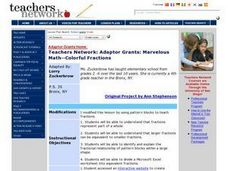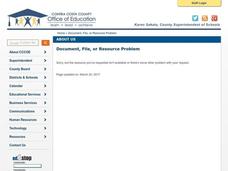Noyce Foundation
Truffles
Knowing how to scale a recipe is an important skill. Young mathematicians determine the amount of ingredients they need to make a certain number of truffles when given a recipe. They determine a relationship between ingredients given a...
Inside Mathematics
Number Towers
Number towers use addition or multiplication to ensure each level is equal. While this is common in factoring, it is often not used with algebraic equations. Solving these six questions relies on problem solving skills and being able to...
Inside Mathematics
Expressions
Strive to think outside of the quadrilateral parallelogram. Worksheet includes two problems applying prior knowledge of area and perimeter to parallelograms and trapezoids. The focus is on finding and utilizing the proper formula and...
Noyce Foundation
Parallelogram
Parallelograms are pairs of triangles all the way around. Pupils measure to determine the area and perimeter of a parallelogram. They then find the area of the tirangles formed by drawing a diagonal of the parallelogram and compare their...
Inside Mathematics
Two Solutions
Many problems in life have more than one possible solution, and the same is true for advanced mathematics. Scholars solve seven problems that all have at least two solutions. Then three higher-level thinking questions challenge them to...
Inside Mathematics
Quadratic (2006)
Most problems can be solved using more than one method. A worksheet includes just nine questions but many more ways to solve each. Scholars must graph, solve, and justify quadratic problems.
Inside Mathematics
Winning Spinners
Winning a spin game is random chance, right? Pupils create a table to determine the sample space of spinning two spinners. Individuals determine the probability of winning a game and then modify the spinners to increase the probability...
Inside Mathematics
Magic Squares
Prompt scholars to complete a magic square using only variables. Then they can attempt to solve a numerical magic square using algebra.
Grammar Net
Numbers 1-30
Jot down some figures with an activity about printing numbers. First, learners fill in the blanks with the numbers next to their printed forms. Then, they complete simple addition and subtraction problems with numbers that are written out.
Curated OER
"Old 300"
Fourth graders combine art and history to assess the importance of the "Old 300." They explore a group of colonists that Stephen F. Austin brought to Texas as the first settlers and then create a time line of major events leading to the...
Curated OER
Teaching Students to Tell Time
Several activities are provided for your young learners to practice telling time. One suggestion is to provide each learner with their own clock. After you read the time, each learner must place the clock's hands in the correct place and...
Curated OER
It's About Time!
Students read a short tutorial and complete one or more online activities. They visit an online math dictionary to learn the value of a day, month, week, and year. In addition, they construct word problems based on a favorite month;...
Curated OER
Be a Structural Engineer!
Students investigate how to design and build items with a focus on structural strength as an engineer would. They complete a truss-building project as a final assessment.
Curated OER
Where are you Spider?
First graders investigate the proximity of objects in space. In this proximity lesson, 1st graders place a felt spider in different locations on a teacher made book, and they describe its proximity to certain items in that book. Students...
Curated OER
"Money In My Pocket"
Second graders assess a brief history of money, the use of money, working with money as well as adding and subtracting with money and how to spend money wisely with responsibility. In addition, they discuss how everything belongs to God...
Curated OER
Million Dollar Project
Students calculate how they will spend a million dollars. In this millionaire math lesson, students complete a worksheet and then make a poster of how they would spend a million dollars. Each item and its cost must be shown. a minimum...
Curated OER
A Trip to Colonial Virginia
Students consider prices while planning a trip to Colonial Virginia. In this budgeting lesson, students construct an itinerary of events for a vacation. Students are responsible for working within the approved budget.
Curated OER
The Hudson's Ups and Downs
Fifth graders practice interpreting line graphs of the Hudson River water levels to assess the tides and tidal cycles in the estuary. They explore how weather can affect water levels and tides and observe that high tides and low tides...
Curated OER
Musical Math
Students play a game of mathematical musical chairs, moving from desk to desk solving addition and subtraction problems.
Curated OER
Marvelous Math -- Colorful Fractions
Students begin the lesson by discovering that a fraction is one part of a whole. In groups, they practice reducting larger fractions into small fractions and discovering they are equal. They use blocks to identify the relationship...
Curated OER
Introducing Models to Elementary School Students
Students explore the concept of models. In this model lesson, students examine 3-dimensional models of various objects and body parts to better understand the natural world.
Curated OER
Candy Math
Second graders in a special education classroom sort candies by color. In groups, they complete various addition problems with the candy and create graphs. They compare and contrast the amounts of candies and answer questions on a...
Curated OER
Plants and Animals: Alike and Not Alike
After reading an informative paragraph that outlines some of the differences between plants and animals, fifth graders attempt to correctly categorize 12 words in a word bank. They must put them in the plant, or animal category. This...
Curated OER
Comparison Shopping
Elementary schoolers explore the concepts associated with comparison shopping, and the concept of need versus want. They also look closely at the power of advertising and become more aware of the messages that ads present. After taking...

























